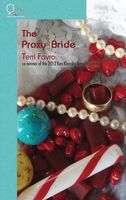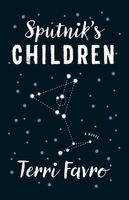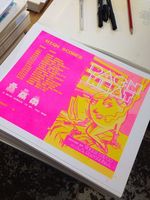Tinker, Tailor, Soldier, Writer
By Koom Kankesan
Terri Favro is a literary gadabout in the best sense of the word. Whenever I turn around, she's doing something new: a Broken Pencil short story challenge, contributing to CBC's contest, putting out a comic book with her husband Ron, participating in a reading, organizing a reading, contributing to a Steam Punk anthology, editing a chapbook of stories that feature Ms Pacman as a noir femme fatale... you get the idea. Between all of these, and her job as a copywriter, Terri has been working on her first full length novel, Sputnik's Children, which will be out with ECW this Spring.
I met her through Quattro where we had both published novellas. She's a warm, social individual and enjoys a wide range of interests from sixties movies to Canadian fiction. Now I find out that she also loves comic books! We caught up and discussed writing and her various endeavours.
Koom: Terri, you and I were published by the same publisher a few years ago but you have moved to a slightly bigger house for your forthcoming book. I want to hear all about the current experience. Is it mostly the same from one publisher to another or is it vastly different?
Terri: Different. A longer editing process, starting earlier, and a longer lead time between final edits and launch to allow for reviews and to build some marketing buzz. The cover was developed early on, and there were several choices, whereas with my first novel, the cover was done in a hurry, as a final step, really. (In fact, I shot the photo on the cover of The Proxy Bride!)
Koom: From what I gather, you're continuing with that world of the 60s in the Niagara region that you established in The Proxy Bride. Why is it important to you to continue building on the same world? Is it a challenge or does it aid your writing process? Did you feel like you were in some way adding to or continuing where your first project left off or is it a completely different beast?
Terri: You’re right: although much of Sputnik’s Children is set an alternate timeline, it’s a version of Shipman’s Corners, the Niagara immigrant neighbourhood I introduced in The Proxy Bride. The neighbourhood also appears in graphic novels I’ve been working on with my partner Ron Edding, including a new one coming out this year called Bella and the Facer Street Gang. It will show up yet again in the The Proxy Bride sequel, Once Upon A Time In West Toronto, which is due out in the fall.
I feel that I’m writing one big story. It’s an impulse you see in other writers who revisit the same characters and places, again and again: Mordecai Richler, Faulkner, Louise Erdrich, to some extent Alice Munro. Interconnected novels that share characters and are based in a fictional world, whether real or imagined, is also popular in genre, whether you’re talking about Ian Rankin’s Inspector Rebus novels or Diana Gabaldon's Outlander series. I enjoy falling into the worlds that these books create and not having to leave them when I move on to another book by the same author.
This may go back to my childhood: I became fixated on the Narnia series and the Hobbit/Lord of the Rings at a very early age. I was also a comic book fan, especially of the DC universe of superheroes, which of course are all interconnected, ongoing stories. For me, as both a writer and reader, a good story does have to stop: it just grows longer, denser and richer. In short, I’ll keep writing about “Shipman’s Corners” until I’m written out.
Your CanLit News
Subscribe to Open Book’s newsletter to get local book events, literary content, writing tips, and more in your inbox
Koom: That's interesting. So do you primarily approach writing fiction through the aspect of story and following threads? As opposed to theme or insight/revelation? For some writers, working through the revelation of theme allows them to structure a novel. How do you know how to shape a project and where to end it?
Terri: For me, it’s all about developing characters and giving them the freedom to reveal themselves through a story that unfolds organically. I usually write my way into the story: I’ll start by placing my character into a particular time, setting and situation and watch what they do. I don’t outline or ‘plot out’ a story but I do try to have an overarching idea about what the story is about –– the so-called ‘elevator pitch’. I find writing those short summaries of a book in progress is helpful in terms of understanding what the book is about: what the characters desire, the problems they have to overcome, and what compels them to keep moving forward. Usually, the starting point is a single character facing a specific problem: for The Proxy Bride, it was a young man, headed for the priesthood, who falls in love with his father’s second wife. Sputnik’s Children is about a woman who creates a superhero comic that reflects an alternate reality she actually believes she lived in –– her comic book series, “Sputnik Chick, Girl With No Past” is the extended memoir of how she saved humanity from a nuclear war in an alternate timeline. Or so she believes. The novel is about her struggle to write an origin story for Sputnik Chick, which is symbolic of her understanding her own past.
Characters drive the stories in all these books. I usually don’t know what will happen to them until I write a first draft. I often think of my characters as ‘imaginary friends’ who live with me, day and night, while I’m writing the book. I dream about them. Sometimes it feels as if they are in the room with me. I think that writing a long work of fiction requires entering a kind of alt-reality.
Koom: The Proxy Bride focused on the Italian Canadian community. Does Sputnik's Children also do that? How much does your Italo-Canadian identity play in your writing in general? How do you go about constructing Canadian identity in your writing? How do you go about constructing that identity in terms of character on the page?
Terri: The Italian Canadian experience is less central to Sputnik’s Children than it was to The Proxy Bride. It's more incidental than critical to the story. I figure that every fictional character has a back story so I let my characters be casually Italian. Why not? They might as well be named Biondi as Smith!
I’ve actually written very little about Italy: there are a couple of chapters set in Venice in The Proxy Bride sequel, and there’s a dream sequence set on the Italian-Austrian front during World War II in Bella and the Facer Street Gang, but that’s about it. I’m more interested in what happens to immigrants in the new world and not always specifically Italian ones. Sputnik’s Children is set in a neighbourhood that is a settlement area for a large number of postwar immigrants from southern and eastern Europe, as well as an African-Canadian community who came to Niagara via the Underground Railroad. It’s a reflection of the area where I grew up, which was very mixed. Italians living next to Poles living next to Ukrainians living next to black families. It was a unique place, and it does turn up a lot in my work.
One aspect of Italian culture that has had a huge impact on my work is, again, the love of a good story. For example, the telling and retelling of a family immigration story until it gains the status of a myth. And also, the folk tales and fairy tales that people passed between themselves and embellished over the centuries – I inherited certain archetypes from my Favro grandfather’s stock of fairytales, in particular. He came from a region in the Alps where people were often snowed in for long stretches, so storytelling was vital to survival as a way to keep your mind occupied while you were snowbound. I heard stories that sound a bit like Jack in the Beanstalk, but darker, sexier, and more violent. (My books are sometimes described that way too.)
Koom: Great! Is there anything else you'd like to say about the writing process or anything at all?
Terri: The more I write, the more of a mystery the process becomes to me. I’ll read something I wrote a year earlier and think -- whoa, I wrote this? How? When? Where did this come from? What’s crawling around in my subconscious that gave rise to this? It's as if I was in a fugue state the whole time I wrote the book. I think there is an element of tapping into the unconscious that is hard to recapture in the cold light of day. Perhaps that's why my characters are always on the edge of disaster -- or falling over the edge. In a fugue state, there is no safety net.
The views expressed in the Writer-in-Residence blogs are those held by the authors and do not necessarily reflect the views of Open Book.
Koom Kankesan was born in Sri Lanka. While his family lived abroad, the civil war in Sri Lanka broke out and this caused them to seek a new home. They eventually settled in Canada and have lived here since the late eighties. He has a background in English Literature and Film Studies. Koom contributed arts journalism to various publications before becoming a high school teacher in the Toronto District School Board. Since working as a teacher, he has taken semesters off now and again to work on his fiction. The Tamil Dream, his new book, is his most ambitious to date. It looks at the end of the civil war in Sri Lanka and how it affected Tamils here in Canada. Besides literature and film, Koom has deep interests in history and science, and an enduring love for comic books.
You can write to Koom throughout January at writer@open-book.ca.





